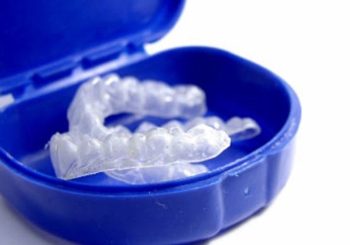If you have invisible braces and want to whiten your teeth during orthodontic treatment, can you use the aligners? Are they strong enough to hold carbamide peroxide bleaching gel?
Some dentists and orthodontists recommend using the aligners as whitening trays, but others don’t. Below are some facts to consider before you begin whitening sessions using trays of any brand*, including:
- Invisalign
- ClearCorrect
- Smile Direct Club
- SmileLove
- SnapCorrect
Teeth Whitening Gel Won’t Harm Most Invisible Braces
Carbamide peroxide won’t harm most invisible aligners or trays, but there are some things to keep in mind.
Teeth whitening trays and orthodontic trays fit differently
- Orthodontic trays have a tighter fit – Invisalign trays fit more securely than trays that are normally used for whitening your teeth. Some people report that the snug fit causes bleaching gel to ooze out. This can result in wasted gel that irritates your gum tissue.
- Don’t leave the bleaching gel in too long – Although you wear Invisalign for 22 hours each day, the bleaching gel should not remain in the trays for that long. All-day bleaching will cause significant sensitivity in your teeth and burn your gums. Also adhere to the designated length of time to wear the gel-filled trays.
- Listen to your dentist – Each patient’s case is different. Follow your dentist’s or orthodontist’s instructions on whether or not you should use the invisible trays to whiten your teeth.
- Whitening might be affected by attachments on your teeth – Sometimes attachments are bonded to your teeth to increase the contact of the aligners with your teeth. Some people report that in the areas beneath the attachments, the bleaching gel was not as effective, and additional whitening sessions were required after the attachments were removed. Others say that their teeth still whitened evenly with the attachments. So keep in mind that results can vary.
Rinse Well
If your dentist approves using your orthodontic trays for teeth whitening, there are several things to keep in mind.
- Teeth whitening gel continues to work until it’s rinsed off.
- Thoroughly rinse your teeth and aligners to ensure they are free of the gel. This will prevent over-whitening your teeth and causing sensitivity.
- Remember that each sent of aligners is worn for two weeks, so ensure they are clean after every whitening session.
Consult with Your Dentist
Although aligners for invisible braces can be used for teeth whitening, you should consult with your dentist to determine if it’s right for you. If any restorative work is to be done on your teeth—or if there are already dental restorations on them—you likely want your brightened teeth to match them. Your dentist will determine the best time to start whitening your teeth.
Whether you received invisible braces like Invisalign or ClearCorrect from your dentist, or if you took the risk of ordering them online from Smile Direct Club, SmileLove, or SnapCorrect*, speak with your dentist about your desire to whiten your teeth. He or she will let you know if bleaching gel will help the stains or make them look worse. Your dentist might recommend that you wait until orthodontic treatment is complete before whitening your teeth.
This post is sponsored by accredited cosmetic dentist Dr. Michael Szarek in Lowell, MA.
*Dr. Szarek does not recommend seeking online orthodontic treatment. There are multiple benefits of in-person treatment and customized care from a dentist.

